Metoprolol and Its Degradation and Transformation Products Using AOPs—Assessment of Aquatic Ecotoxicity Using QSAR
Abstract
1. Introduction
2. Materials and Methods
2.1. Chemicals and Reagents
2.2. Photodegradation Experiments
2.3. Ozonation
2.4. HPLC-HRMS
2.5. Kinetic Analysis of the Photodegradation
2.6. Assessment of Ecotoxicology
3. Results and Discussion
3.1. Photoinduced Degradation of Metoprolol—Kinetic Modelling of Degradation
3.2. Photoinduced Degradation of Metoprolol—Product Characterization
3.3. Ozonation of Metoprolol
3.4. Assessment of Ecotoxicity with QSAR Analysis
4. Conclusions
Author Contributions
Funding
Institutional Review Board Statement
Informed Consent Statement
Data Availability Statement
Conflicts of Interest
References
- aus der Beek, T.; Weber, F.-A.; Bergmann, A.; Grüttner, G.; Carius, A. Pharmaceuticals in the Environment: Global Occurrence and Potential Cooperative Action under the Strategic Approach to International Chemicals Management (SAICM); Texte; Umweltbundesamt: Dessau, Germany, 2016; Volume 67. [Google Scholar]
- Eike, D.; Marcus, R.; Dirk, J. The Database “Pharmaceuticals in the Environment”-Update and New Analysis; Texte; Umweltbundesamt: Dessau, Germany, 2019; Volume 67. [Google Scholar]
- Santos, L.H.M.L.; Araújo, A.N.; Fachini, A.; Pena, A.; Delerue-Matos, C.; Montenegro, M.C.B.S.M. Ecotoxicological aspects related to the presence of pharmaceuticals in the aquatic environment. J. Hazard. Mater. 2010, 175, 45–95. [Google Scholar] [CrossRef]
- Maszkowska, J.; Stolte, S.; Kumirska, J.; Łukaszewicz, P.; Mioduszewska, K.; Puckowski, A.; Caban, M.; Wagil, M.; Stepnowski, P.; Białk-Bielińska, A. Beta-blockers in the environment: Part II. Ecotoxicity study. Sci. Total Environ. 2014, 493, 1122–1126. [Google Scholar] [CrossRef]
- Fick, J.; Söderström, H.; Lindberg, R.H.; Phan, C.; Tysklind, M.; Larsson, D.G.J. Pharmaceuticals and Personal Care Products in the Environment Contamination of Surface, Ground, and Drinking Water from Pharmaceutical Production. Environ. Toxicol. Chem. 2009, 28, 2522–2527. [Google Scholar] [CrossRef] [PubMed]
- Maszkowska, J.; Stolte, S.; Kumirska, J.; Łukaszewicz, P.; Mioduszewska, K.; Puckowski, A.; Caban, M.; Wagil, M.; Stepnowski, P.; Białk-Bielińska, A. Beta-blockers in the environment: Part I. Mobility and hydrolysis study. Sci. Total Environ. 2014, 493, 1112–1121. [Google Scholar] [CrossRef] [PubMed]
- Voigt, M.; Wirtz, A.; Hoffmann-Jacobsen, K.; Jaeger, M. Prior art for the development of a fourth purification stage in wastewater treatment plant for the elimination of anthropogenic micropollutants-a short-review. AIMS Environ. Sci. 2020, 7, 69–98. [Google Scholar] [CrossRef]
- Yang, Y.; Ok, Y.S.; Kim, K.H.; Kwon, E.E.; Tsang, Y.F. Occurrences and removal of pharmaceuticals and personal care products (PPCPs) in drinking water and water/sewage treatment plants: A review. Sci. Total Environ. 2017, 596–597, 303–320. [Google Scholar] [CrossRef] [PubMed]
- Deng, Y.; Zhao, R. Advanced Oxidation Processes (AOPs) in Wastewater Treatment. Curr. Pollut. Rep. 2015, 1, 167–176. [Google Scholar] [CrossRef]
- Parsons, S. Advanced Oxidation Processes for Water and Wastewater Treatment; IWA Publishing: London, UK, 2004. [Google Scholar]
- Oppenländer, T. Photochemical Purification of Water and Air: Advanced Oxidation Processes (AOPs): Principles, Reaction Mechanisms, Reactor Concepts (Chemistry); WILEY-VCH Verlag: Weinheim, Germany, 2003; ISBN 3-527-30463-7. [Google Scholar]
- Collivignarelli, M.C.; Abbà, A.; Miino, M.C.; Caccamo, F.M.; Torretta, V.; Rada, E.C.; Sorlini, S. Disinfection of wastewater by uv-based treatment for reuse in a circular economy perspective. Where are we at? Int. J. Environ. Res. Public Health 2021, 18, 77. [Google Scholar] [CrossRef]
- Fatta-Kassinos, D.; Vasquez, M.I.; Kümmerer, K. Transformation products of pharmaceuticals in surface waters and wastewater formed during photolysis and advanced oxidation processes-degradation, elucidation of byproducts and assessment of their biological potency. Chemosphere 2011, 85, 693–709. [Google Scholar] [CrossRef]
- Vasconcelos, T.G.; Henriques, D.M.; König, A.; Martins, A.F.; Kümmerer, K. Photo-degradation of the antimicrobial ciprofloxacin at high pH: Identification and biodegradability assessment of the primary by-products. Chemosphere 2009, 76, 487–493. [Google Scholar] [CrossRef]
- Fick, J.; Andersson, P.L.; Johansson, M. Selection of Antibiotics: A Chemometric Approach Method. In Proceedings of the 4th International Conference Pharmaceuticals and Endocrine Disrupting Chemicals in Water, Minneapolis, MN, USA, 13–15 October 2004; pp. 143–150. [Google Scholar]
- Wold, S.S.M.; Eriksson, L.; Sjöström, M.; Eriksson, L. PLS-regression: A basic tool of chemometrics. Chemom. Intell. Lab. Syst. 2001, 58, 109–130. [Google Scholar] [CrossRef]
- Veith, G.D.; Mekenyan, O.G. A QSAR Approach for Estimating the Aquatic Toxicity of Soft Electrophiles [QSAR for Soft Electrophiles]. Quant. Struct. Relatsh. 1993, 12, 349–356. [Google Scholar] [CrossRef]
- Pavan, M.; Worth, A.; Netzeva, T. Comparative Assessment of QSAR Models for Aquatic Toxicity; European Communities: Ispra, Italy, 2005. [Google Scholar]
- Benfenati, E. E Book Theory, Guidance and Applications on QSAR and REACH; Orchestra: Milan, Italy, 2012; ISBN 9788890240546. [Google Scholar]
- Dimitrov, S.D.; Diderich, R.; Sobanski, T.; Pavlov, T.S.; Chankov, G.V.; Chapkanov, A.S.; Karakolev, Y.H.; Temelkov, S.G.; Vasilev, R.A.; Gerova, K.D.; et al. QSAR Toolbox–workflow and major functionalities. SAR QSAR Environ. Res. 2016, 27, 203–219. [Google Scholar] [CrossRef]
- Kuhn, H.; Braslavsky, S.E.; Schmidt, R. Chemical Actinometry. (IUPAC technical report). Pure Appl. Chem. 2004, 76, 2105–2146. [Google Scholar] [CrossRef]
- Hatchard, C.G.; Parker, C. A New Sensitive Chemical Actinometer. II. Potassium Ferrioxalate as a Standard Chemical Actinometer. Proc. R. Soc. A Math. Phys. Eng. Sci. 1956, 235, 518–536. [Google Scholar] [CrossRef]
- Kochany, J.; Bolton, J. of aqueous organic pollutants. 1. EPR spin-trapping technique for the determination of hydroxyl radical rate constants in the photooxidation of chlorophenols following. J. Phys. Chem. 1991, 95, 5116–5120. [Google Scholar] [CrossRef]
- Sun, L.; Bolton, J.R. Determination of the Quantum Yield for the Photochemical Generation of Hydroxyl Radicals in TiO2 Suspensions. J. Phys. Chem. 1996, 100, 4127–4134. [Google Scholar] [CrossRef]
- Voigt, M.; Hentschel, B.; Theiss, N.; Savelsberg, C.; Bartels, B.; Nickisch-Hartfiel, A.; Jaeger, M. Lomefloxacin—Occurrence in the German River Erft, Its Photo-Induced Elimination, and Assessment of Ecotoxicity. Clean Technol. 2020, 2, 74–90. [Google Scholar] [CrossRef]
- Voigt, M.; Jaeger, M. Structure and QSAR analysis of photoinduced transformation products of neonicotinoids from EU watchlist for ecotoxicological assessment. Sci. Total Environ. 2021, 751, 141634. [Google Scholar] [CrossRef]
- Voigt, M.; Bartels, I.; Nickisch-Hartfiel, A.; Jaeger, M. Determination of minimum inhibitory concentration and half maximal inhibitory concentration of antibiotics and their degradation products to assess the eco-toxicological potential. Toxicol. Environ. Chem. 2019, 101, 315–338. [Google Scholar] [CrossRef]
- Voigt, M.; Savelsberg, C.; Jaeger, M. Identification of Pharmaceuticals in The Aquatic Environment Using HPLC-ESI-Q-TOF-MS and Elimination of Erythromycin Through Photo-Induced Degradation. J. Vis. Exp. 2018. [Google Scholar] [CrossRef] [PubMed]
- Voigt, M.; Bartels, I.; Nickisch-Hartfiel, A.; Jaeger, M. Elimination of macrolides in water bodies using photochemical oxidation. AIMS Environ. Sci. 2018, 5, 372–388. [Google Scholar] [CrossRef]
- Abramović, B.; Kler, S.; Šojić, D.; Laušević, M.; Radović, T.; Vione, D. Photocatalytic degradation of metoprolol tartrate in suspensions of two TiO2-based photocatalysts with different surface area. Identification of intermediates and proposal of degradation pathways. J. Hazard. Mater. 2011, 198, 123–132. [Google Scholar] [CrossRef] [PubMed]
- Cavalcante, R.P.; Dantas, R.F.; Bayarri, B.; González, O.; Giménez, J.; Esplugas, S.; Machulek, A. Photocatalytic mechanism of metoprolol oxidation by photocatalysts TiO2 and TiO2 doped with 5% B: Primary active species and intermediates. Appl. Catal. B Environ. 2016, 194, 111–122. [Google Scholar] [CrossRef]
- Gao, Y.-Q.; Zhang, J.; Li, C.; Tian, F.-X.; Gao, N.-Y. Comparative evaluation of metoprolol degradation by UV/chlorine and UV/H2O2 processes. Chemosphere 2020, 243, 125325. [Google Scholar] [CrossRef]
- Filipe, O.M.S.; Mota, N.; Santos, S.A.O.; Domingues, M.R.M.; Silvestre, A.J.D.; Neves, M.G.P.M.S.; Simões, M.M.Q.; Santos, E.B.H. Identification and characterization of photodegradation products of metoprolol in the presence of natural fulvic acid by HPLC-UV-MSn. J. Hazard. Mater. 2017, 323, 250–263. [Google Scholar] [CrossRef]
- Neves, C.M.B.; Filipe, O.M.S.; Mota, N.; Santos, S.A.O.; Silvestre, A.J.D.; Santos, E.B.H.; Neves, M.G.P.M.S.; Simões, M.M.Q. Photodegradation of metoprolol using a porphyrin as photosensitizer under homogeneous and heterogeneous conditions. J. Hazard. Mater. 2019, 370, 13–23. [Google Scholar] [CrossRef]
- Píš͗ková, V.; Tasbihi, M.; Vávrová, M.; Štangar, U.L. Photocatalytic degradation of β-blockers by using immobilized titania/silica on glass slides. J. Photochem. Photobiol. A Chem. 2015, 305, 19–28. [Google Scholar] [CrossRef]
- Romero, V.; González, O.; Bayarri, B.; Marco, P.; Giménez, J.; Esplugas, S. Performance of different advanced oxidation technologies for the abatement of the beta-blocker metoprolol. Catal. Today 2015, 240, 86–92. [Google Scholar] [CrossRef]
- Romero, V.; González, O.; Bayarri, B.; Marco, P.; Giménez, J.; Esplugas, S. Degradation of Metoprolol by photo-Fenton: Comparison of different photoreactors performance. Chem. Eng. J. 2016, 283, 639–648. [Google Scholar] [CrossRef]
- Šojić, D.; Despotović, V.; Orčić, D.; Szabó, E.; Arany, E.; Armaković, S.; Illés, E.; Gajda-Schrantz, K.; Dombi, A.; Alapi, T.; et al. Degradation of thiamethoxam and metoprolol by UV, O3 and UV/O3 hybrid processes: Kinetics, degradation intermediates and toxicity. J. Hydrol. 2012, 472–473, 314–327. [Google Scholar] [CrossRef]
- Yu, Y.; Liu, Y.; Wu, X.; Weng, Z.; Hou, Y.; Wu, L. Enhanced visible light photocatalytic degradation of metoprolol by Ag-Bi2WO6-graphene composite. Sep. Purif. Technol. 2015, 142, 1–7. [Google Scholar] [CrossRef]
- Jaén-Gil, A.; Buttiglieri, G.; Benito, A.; Mir-Tutusaus, J.A.; Gonzalez-Olmos, R.; Caminal, G.; Barceló, D.; Sarrà, M.; Rodriguez-Mozaz, S. Combining biological processes with UV/H2O2 for metoprolol and metoprolol acid removal in hospital wastewater. Chem. Eng. J. 2021, 404, 126482. [Google Scholar] [CrossRef]
- Armaković, S.J.; Armaković, S.; Finčur, N.L.; Šibul, F.; Vione, D.; Šetrajčić, J.P.; Abramović, B.F. Influence of electron acceptors on the kinetics of metoprolol photocatalytic degradation in TiO2 suspension. A combined experimental and theoretical study. RSC Adv. 2015, 5, 54589–54604. [Google Scholar] [CrossRef]
- Borkar, R.M.; Raju, B.; Srinivas, R.; Patel, P.; Shetty, S.K. Identification and characterization of stressed degradation products of metoprolol using LC/Q-TOF-ESI-MS/MS and MSn experiments. Biomed. Chromatogr. 2012, 26, 720–736. [Google Scholar] [CrossRef] [PubMed]
- Romero, V.; De La Cruz, N.; Dantas, R.F.; Marco, P.; Giménez, J.; Esplugas, S. Photocatalytic treatment of metoprolol and propranolol. Catal. Today 2011, 161, 115–120. [Google Scholar] [CrossRef]
- Gao, Y.Q.; Zhang, J.; Zhou, J.Q.; Li, C.; Gao, N.Y.; Yin, D.Q. Persulfate activation by nano zero-valent iron for the degradation of metoprolol in water: Influencing factors, degradation pathways and toxicity analysis. RSC Adv. 2020, 10, 20991–20999. [Google Scholar] [CrossRef]
- Faber, H.; Lutze, H.; Lareo, P.L.; Frensemeier, L.; Vogel, M.; Schmidt, T.C.; Karst, U. Liquid chromatography/mass spectrometry to study oxidative degradation of environmentally relevant pharmaceuticals by electrochemistry and ozonation. J. Chromatogr. A 2014, 1343, 152–159. [Google Scholar] [CrossRef]
- Radjenovic, J.; Escher, B.I.; Rabaey, K. Electrochemical degradation of the β-blocker metoprolol by Ti/Ru0.7Ir0.3O2 and Ti/SnO2-Sb electrodes. Water Res. 2011, 45, 3205–3214. [Google Scholar] [CrossRef]
- Benner, J.; Ternes, T.A. Ozonation of metoprolol: Elucidation of oxidation pathways and major oxidation products. Environ. Sci. Technol. 2009, 43, 5472–5480. [Google Scholar] [CrossRef] [PubMed]
- Tay, K.S.; Rahman, N.A.; Abas, M.R.B. Ozonation of metoprolol in aqueous solution: Ozonation by-products and mechanisms of degradation. Environ. Sci. Pollut. Res. 2013, 20, 3115–3121. [Google Scholar] [CrossRef] [PubMed]
- Wilde, M.L.; Montipó, S.; Martins, A.F. Degradation of β-blockers in hospital wastewater by means of ozonation and Fe2+/ozonation. Water Res. 2014, 48, 280–295. [Google Scholar] [CrossRef] [PubMed]
- Heger, S.; Brendt, J.; Hollert, H.; Roß-Nickoll, M.; Du, M. Green toxicological investigation for biofuel candidates. Sci. Total Environ. 2021, 764, 142902. [Google Scholar] [CrossRef] [PubMed]
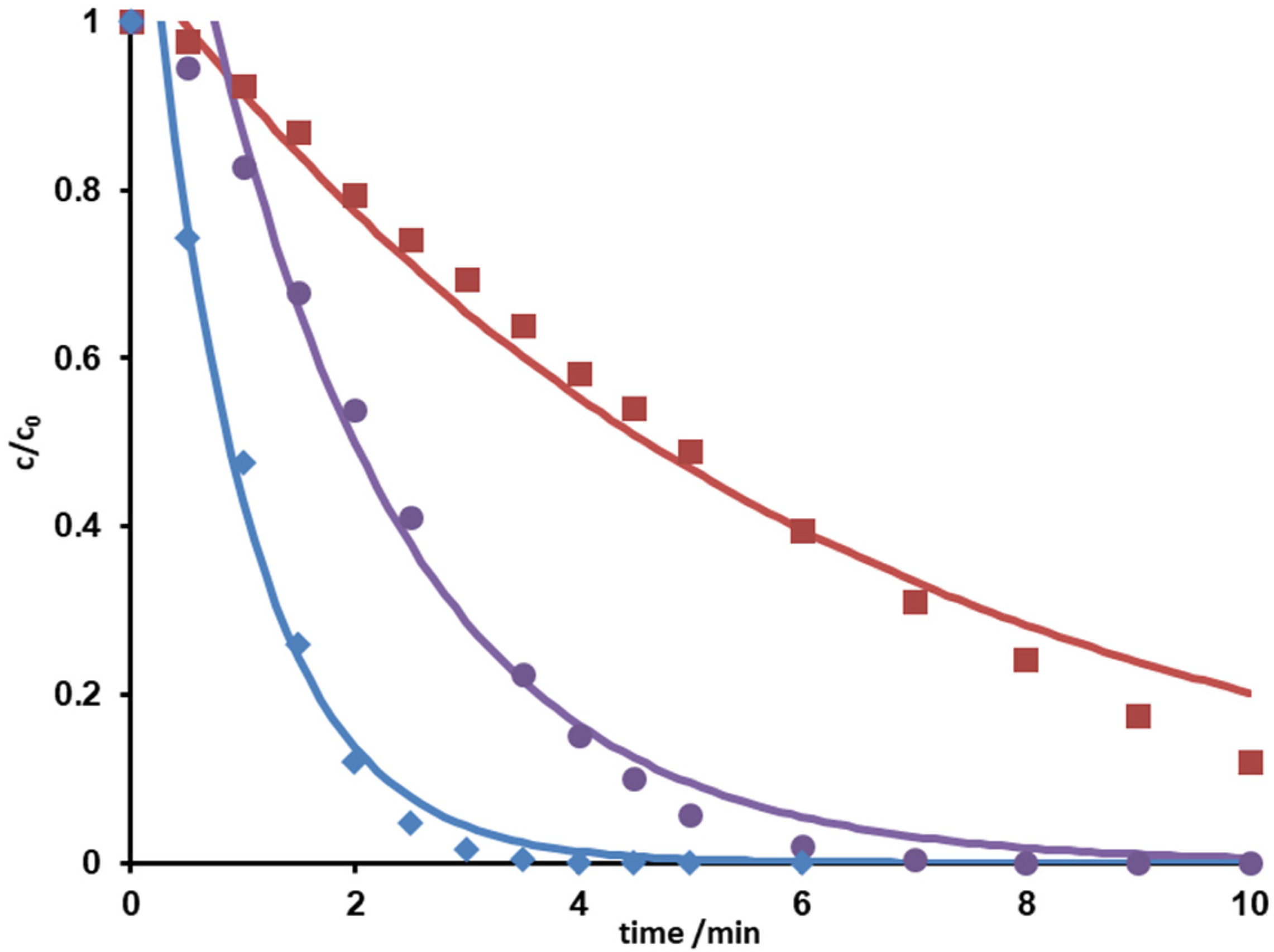

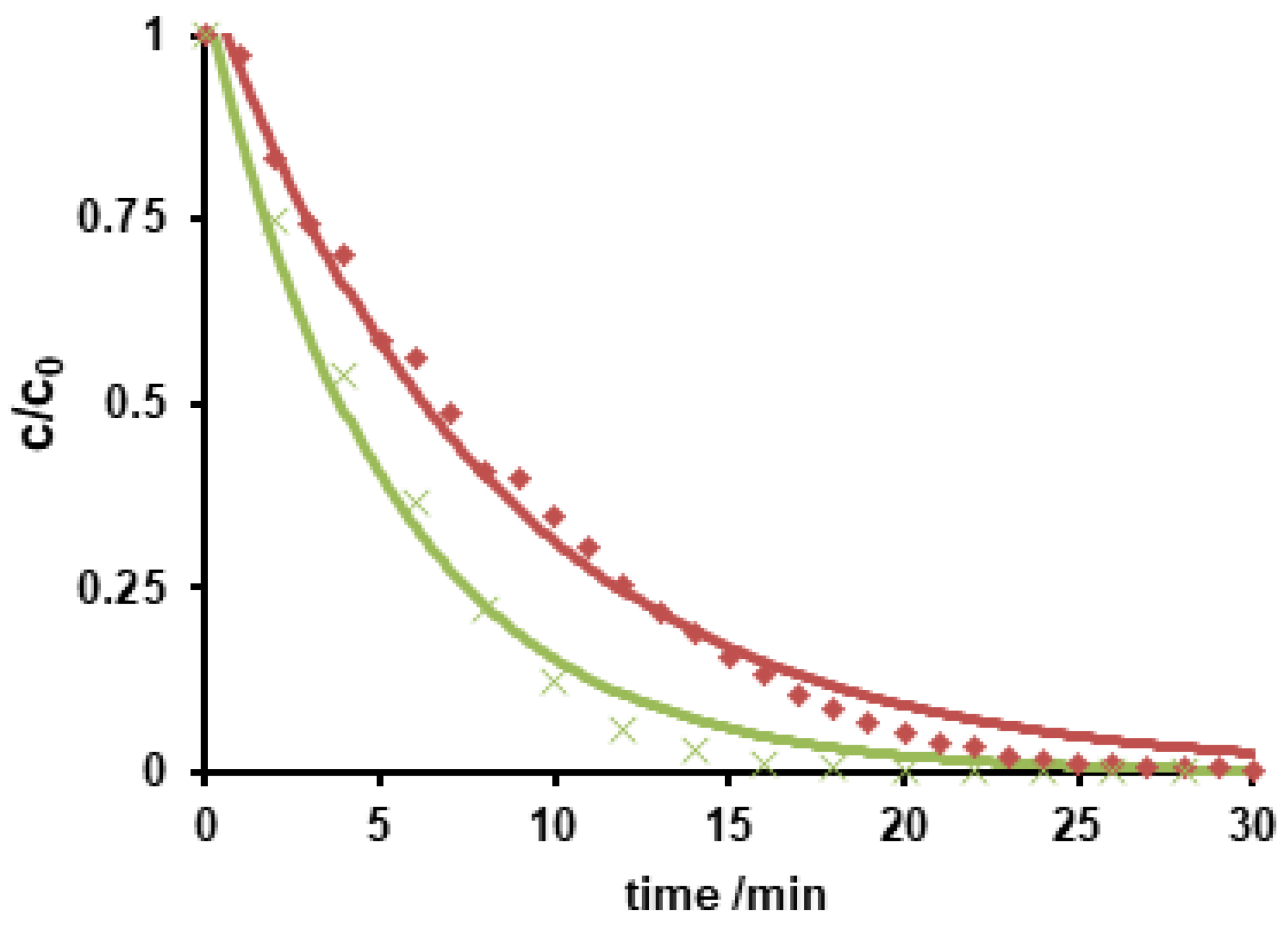

| pH | H2O2/mg L−1 | k/min−1 | t ½/min |
|---|---|---|---|
| 3 | - | 0.20 | 3.44 |
| 6 | - | 0.18 | 3.76 |
| 9 | - | 0.18 | 3.94 |
| 6 | 10 | 0.55 | 1.26 |
| 6 | 30 | 1.14 | 0.61 |
| Retention Time/min | [M+H] + (exact) | [M+H]+(accurate) | Proposed Structure | Reference |
|---|---|---|---|---|
| 5.1 | 268.1907 | 268.1831 |  | Metoprolol |
| 2.9; 3.4; 4.1 | 284.1856 | 284.1796 |  | [30,31,32,33,34,35,36,37,38,39,40] |
| 4.8; 5.0 | 282.1700 | 282.1612 |  | [30,31,32,33,34,36,37,38,39,40,41] |
| 3.9 | 254.1387 | 254.1638 | 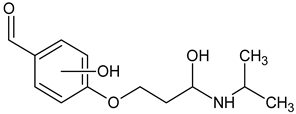 | [30,31,32,33,34,35,37,38,40,41] |
| 4.2 | 252.1594 | 252.1533 | 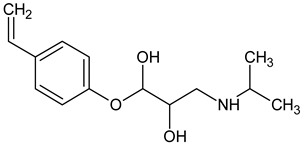 | [30,31,33,34,37,38,40] |
| 4.1 | 238.1438 | 238.1379 | 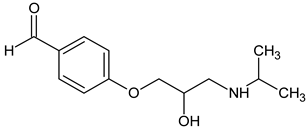 | [30,31,33,34,35,36,37,38,39,40,42] |
| 1.4 | 134.1176 | 134.1127 |  | [30,31,32,34,35,36,37,38,39,40,41,43] |
| Retention Time/min | [M+H]+(exact) | [M+H]+(accurate) | Proposed Structure | Reference |
|---|---|---|---|---|
| 5.9 | 268.1907 | 268.1872 |  | Metoprolol |
| 5.3; 5.4 | 300.1805 | 300.1770 |  | [30,31,34,39,40,47,48,49] |
| 5.2; 5.8 | 282.1700 | 282.1703 |  | [30,31,32,33,34,36,37,38,39,40,41,45] |
| 5.2; 5.3 | 274.1649 | 274.1615 |  | [47,48] |
| 1.8 | 206.1023 | 206.0991 |  | [34,48] |
| 1.4 | 134.1176 | 134.1150 |  | [30,31,32,34,35,36,37,38,39,40,41,43,48,49] |
| Daphnid (Branchiopoda) | Fish (Actinopterygii) | Green Algae | Pimephales promelas (Fathead Minnow) | |||||||
|---|---|---|---|---|---|---|---|---|---|---|
| 48 h LC50/mg∙L−1 | ChV /mg∙L−1 | 96 h LC50/mg∙L−1 | ChV /mg∙L−1 | 96 h EC50 /mg∙L−1 | ChV /mg∙L−1 | M1—LC50/mg∙L−1 | M2—LC50/mg∙L−1 | M3—LC50/mg∙L−1 | M4—LC50/mg∙L−1 | |
| Meto-prolol | 9.44 | 0.75 | 82.1 | 5.33 | 8.36 | 2.71 | 144 | 208 | 437 | 111 |
| 134 | 170 | 10.1 | 2 × 103 | 322 | 272 | 71.0 | 3.04 × 104 | 1.25 × 104 | 3.57 × 104 | 3.99 × 103 |
| 206 | 2.88 | 0.25 | 23.2 | 1.20 | 2.20 | 0.75 | N.p. | 46.8 | 90.9 | 28.4 |
| 238 | 15.5 | 1.17 | 142 | 10.8 | 15.2 | 4.73 | 228 | 420 | 928 | 205 |
| 252 | 17.8 | 1.34 | 164 | 12.8 | 17.7 | 5.50 | 161 | 497 | 1.11 × 103 | 240 |
| 254 | 94.7 | 6.21 | 1 × 103 | 119 | 124 | 34.8 | N.p. | 4.61 × 103 | 1.18 × 104 | 1.75 × 103 |
| 274 | 107 | 6.96 | 1.13 × 103 | 135 | 140 | 39.3 | N.p. | 5.26 × 103 | 1.36 × 104 | 1.99 × 103 |
| 282 (a) | N.p. | N.p. | N.p. | N.p. | N.p. | N.p. | N.p. | 1.44 × 103 | 3.41 × 103 | 627 |
| 282 (b) | 65.4 | 4.46 | 666 | 69.8 | 79.1 | 22.8 | N.p. | 2.72 × 103 | 6.7 × 103 | 1.11 × 103 |
| 282 (c) | 38.5 | 2.74 | 375 | 34.3 | 42.6 | 12.7 | N.p. | 1.34 × 103 | 3.15 × 103 | 587 |
| 284 (a) | 48.5 | 3.38 | 481 | 46.6 | 55.7 | 16.4 | N.p. | 1.81 × 103 | 4.36 × 103 | 772 |
| 284 (b) | 19.6 | 1.47 | 180 | 13.9 | 19.4 | 6.01 | N.p. | 540 | 1.2 × 103 | 262 |
| 284 (c) | 27.7 | 2.03 | 262 | 22.1 | 29.1 | 8.84 | N.p. | 860 | 1.97 × 103 | 397 |
| 284 (d) | 48.5 | 3.38 | 481 | 46.6 | 55.7 | 16.4 | N.p. | 1.81 × 103 | 4.36 × 103 | 772 |
| 284 (e) | 48.5 | 3.38 | 481 | 46.6 | 55.7 | 16.4 | N.p. | 1.81 × 103 | 4.36 × 103 | 772 |
| 300 (a) | 57.3 | 3.96 | 573 | 57.2 | 67 | 19.6 | N.p. | 2.23 × 103 | 5.40 × 103 | 931 |
| 300 (b) | 57.3 | 3.96 | 573 | 57.2 | 67 | 19.6 | N.p. | 2.23 × 103 | 5.40 × 103 | 931 |
| 300 (c) | 40.4 | 2.87 | 393 | 35.9 | 44.6 | 13.3 | N.p. | 1.4 × 103 | 3.29 × 103 | 614 |
| Fish | Fathead Minnow | Daphnia Magna | Algae | ||||||||||||
|---|---|---|---|---|---|---|---|---|---|---|---|---|---|---|---|
| Acute (LC50)/mg∙L−1 | Chronic (NO EC)/mg∙L−1 | LC50 96 h/mg∙L−1 | LC50/mg∙L−1 | LC50 48 h /mg∙L−1 | Acute (EC50)/mg∙L−1 | Chronic (NOEC)/mg∙L−1 | Acute (EC50)/mg∙L−1 | Chronic (NOEC)/mg∙L−1 | |||||||
| KNN/Read-Across 1.0.0 | NIC 1.0.0 | IRFMN 1.0.0 | IRFMN/Combase 1.0.0 | IRFMN 1.0.0 | EPA 1.0.7 | KNN/IRFMN 1.1.0 | EPA 1.0.7 | DEMETRA 1.0.4 | IRFMN 1.0.0 | IRFMN/Combase 1.0.0 | IRFM 1.0.0 | IRFMN 1.0.0 | ProtoQSAR/Combase 1.0.0 | IRFMN 1.0.0 | |
| Metoprolol | 13.8 | 1.1 | 5.0 | 2.3 | 0.18 | 73.9 | 3.8 | 2.3 | 2.22 | 170 | 5.7 × 10−3 | 7.96 | 4.6 | 57.70 | 1.03 |
| 134 | 4019.8 | 512.0 | 15.6 | 268.5 | 3.40 | 1650.8 | 4091.4 | 1434.4 | 25.63 | 154 | 2.5 | 7.11 | 53.3 | 3.15 | 15.42 |
| 206 | 3056.1 | 93.7 | 17.4 | 64.1 | 0.65 | 694.1 | N.p. | 6727.0 | 393.32 | 102 | 1.11 | 10.4 | 21.2 | 26.84 | 18.96 |
| 238 | 13.0 | 3.4 | 4.7 | 3.2 | 0.25 | 102.6 | 13.5 | 4.7 | 7.51 | 44 | 1.4 × 10−2 | 7.72 | 5.3 | 0.85 | 2.17 |
| 252 | 16.7 | 3.6 | 5.4 | 1.7 | 0.15 | 40.7 | 12.7 | 50.6 | 6.32 | 4 | 3.3 × 10−3 | 7.73 | 4.1 | 0.74 | 1.52 |
| 254 | 28.0 | 5.2 | 4.5 | 2.5 | 0.29 | 14.6 | 27.0 | 64.1 | 47.49 | 450 | 0.18 | 7.39 | 9.9 | 0.08 | 1.09 |
| 274 | 1.76 | 19.9 | 3.31 | 3.0 | 0.31 | 222.1 | 0.6 | 9.0 | 6.5 | 751 | 0.36 | 9.18 | 8.0 | 101.64 | 1.78 |
| 282 (a) | 14.0 | 1.1 | 8.7 | 1.8 | 0.19 | 63.8 | 4.1 | 1.9 | 6.20 | 217 | 1.9 × 10−2 | 10.09 | 4.9 | 63.79 | 1.16 |
| 282 (b) | 21.7 | 1.1 | 5.2 | 2.8 | 0.18 | 88.6 | 4.5 | 2.2 | 7.43 | 285 | 1.7 × 10−2 | 11.16 | 4.4 | 0.69 | 0.98 |
| 282 (c) | 29.6 | 1.1 | 7.9 | 3.0 | 0.20 | 47.1 | 13.0 | 1.9 | 1.41 | 188 | 4.9 × 10−3 | 8.77 | 4.7 | 0.67 | 1.23 |
| 284 (a) | 35.8 | 1.2 | 6.4 | 4.4 | 0.19 | 212.7 | 4.3 | 45.0 | 7.40 | 335 | 1.3 × 10−2 | 10.96 | 4.2 | 0.69 | 1.50 |
| 284 (b) | 36.7 | 1.2 | 5.8 | 7.6 | 0.19 | 81.4 | 4.5 | 40.9 | 22.11 | 276 | 2.0 × 10−3 | 8.33 | 5.8 | 62.70 | 1.13 |
| 284 (c) | 16.4 | 1.2 | 6.6 | 6.6 | 0.19 | 91.4 | 4.4 | 35.4 | 22.63 | 237 | 6.5 × 10−3 | 9.49 | 5.4 | 10.36 | 1.04 |
| 284 (d) | 35.7 | 1.2 | 7.2 | 4.6 | 0.22 | 89.9 | 4.3 | 38.5 | 6.49 | 202 | 3.7 × 10−3 | 11.37 | 5.3 | 0.67 | 1.13 |
| 284 (e) | 35.8 | 1.2 | 5.6 | 8.2 | 0.19 | 132.6 | 4.3 | 47.3 | 5.78 | 7 | 1.7 × 10−2 | 9.79 | 4.9 | 53.5 | 1.13 |
| 300 (a) | 17.1 | 36.6 | 4.8 | 5.7 | 0.27 | 86.3 | 23.7 | 647.0 | 82.16 | 322 | 2.4 × 10−3 | 9.82 | 7.9 | 10.13 | 1.29 |
| 300 (b) | 17.1 | 36.6 | 5.7 | 4.1 | 0.23 | 91.3 | 23.7 | 722.3 | 81.5 | 394 | 2.4 × 10−3 | 9.41 | 8.6 | 12.04 | 1.06 |
| 300 (c) | 36.9 | 36.6 | 5.5 | 4.2 | 0.18 | 82.2 | 4.9 | 793.9 | 75.5 | 314 | 8.0 × 10−4 | 7.6 | 13.5 | 0.76 | 1.48 |
Publisher’s Note: MDPI stays neutral with regard to jurisdictional claims in published maps and institutional affiliations. |
© 2021 by the authors. Licensee MDPI, Basel, Switzerland. This article is an open access article distributed under the terms and conditions of the Creative Commons Attribution (CC BY) license (https://creativecommons.org/licenses/by/4.0/).
Share and Cite
Voigt, M.; Bartels, I.; Schmiemann, D.; Votel, L.; Hoffmann-Jacobsen, K.; Jaeger, M. Metoprolol and Its Degradation and Transformation Products Using AOPs—Assessment of Aquatic Ecotoxicity Using QSAR. Molecules 2021, 26, 3102. https://doi.org/10.3390/molecules26113102
Voigt M, Bartels I, Schmiemann D, Votel L, Hoffmann-Jacobsen K, Jaeger M. Metoprolol and Its Degradation and Transformation Products Using AOPs—Assessment of Aquatic Ecotoxicity Using QSAR. Molecules. 2021; 26(11):3102. https://doi.org/10.3390/molecules26113102
Chicago/Turabian StyleVoigt, Melanie, Indra Bartels, Dorothee Schmiemann, Lars Votel, Kerstin Hoffmann-Jacobsen, and Martin Jaeger. 2021. "Metoprolol and Its Degradation and Transformation Products Using AOPs—Assessment of Aquatic Ecotoxicity Using QSAR" Molecules 26, no. 11: 3102. https://doi.org/10.3390/molecules26113102
APA StyleVoigt, M., Bartels, I., Schmiemann, D., Votel, L., Hoffmann-Jacobsen, K., & Jaeger, M. (2021). Metoprolol and Its Degradation and Transformation Products Using AOPs—Assessment of Aquatic Ecotoxicity Using QSAR. Molecules, 26(11), 3102. https://doi.org/10.3390/molecules26113102






